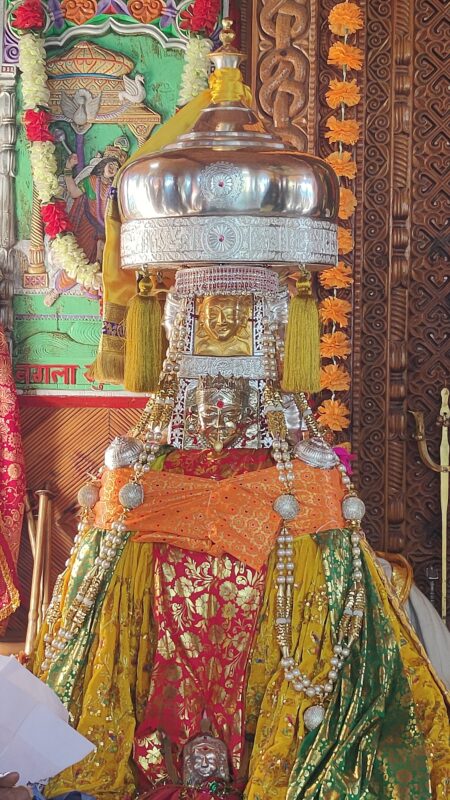Mata Baglamukhi holds significant recognition in Sanatan Dharma. According to the ancient Vedic Tantra, there are 10 Mahavidyas—goddesses worshipped by Tantrikas to gain power or siddhi (spiritual accomplishment). Among these, Mata Baglamukhi is particularly revered.
Significance of Maa Baglamukhi
Mata Baglamukhi is known for her ability to destroy the misunderstandings, illusions, and enemies of her devotees. The name “Bagla” or “Valga” is derived from Sanskrit, meaning “to tighten the reins” or “to put a rein.” Over time, the word evolved to “Wagla” and then “Bagla.” The goddess has 108 different names, with some scholars suggesting as many as 1108.
Maa Baglamukhi is worshipped not only in North India but also in South India, the northeastern states, and Nepal. In North India, she is also known as Pitambari, a name given due to her special love for the color yellow and yellow items.
The Form of Mata Baglamukhi
Mata Baglamukhi’s form is described as divine and majestic. She is depicted seated on a golden throne adorned with yellow pillars and various gems. The goddess has three large eyes, symbolizing her ability to provide ultimate knowledge to her devotees. In her divine form, she is often shown pulling the tongue of the demon Madan with one hand while holding a mace in the other.
The Origin of Mata Baglamukhi
Two primary stories describe the origin of Mata Baglamukhi:
- The Great Deluge in Satyayuga: During the Satyayuga, a great deluge threatened to submerge the world. Brahma, the creator of the universe, prayed to Lord Vishnu for protection. Vishnu, in turn, performed penance to please Mahashakti on the banks of the Haridra Sarovar, a lake yellow like turmeric. Pleased with his penance, Mahashakti manifested Mata Baglamukhi from the lake’s yellow waters. Mata Baglamukhi pacified the storm, restoring balance to the universe.
- The Demon Madan: Another story tells of a demon named Madan, who attained Vaak Siddhi (the power of speech) from Lord Shiva through intense penance. Madan misused this power to torment humans. The gods, seeking protection, prayed to Mata Baglamukhi. She assured them of protection and fought a fierce battle with Madan. During the battle, she immobilized his speech by holding his tongue. Before dying, Madan requested that he be worshipped alongside the goddess. Granting his wish, Mata Baglamukhi killed him, and he is now depicted alongside her in her divine form.
Forms of Mata Baglamukhi
Most Baglamukhi temples in India feature two-armed or two-handed idols of the goddess, representing her gentle form. She is often depicted sitting on a lotus flower, holding a mace in her right hand and the tongue of the demon in her left. This form symbolizes her power to stun and silence enemies.
In some rare instances, four-handed idols are found. These portray Mata Baglamukhi with a golden throne, a third eye, a yellow half-moon on her forehead, and fully adorned with gold ornaments.
Worship of Mata Baglamukhi
Mata Baglamukhi is worshipped for various reasons:
- Stambhan (Stunning the Enemy): She is believed to have the power to immobilize enemies or silence them by taking away their power of speech. Devotees often worship her to win court cases or defeat adversaries.
- Spiritual Powers: The ‘Baglamukhi Stotram’ praises her for granting supernatural powers, wealth, good fortune, and prosperity.
- Victory and Protection: Devotees seek her blessings to achieve victory in battles, resolve crises, and gain protection from adversaries.
Mata Baglamukhi’s worship is deeply rooted in Sanatan Dharma, embodying the tantric traditions that emphasize spiritual power and protection. Her divine form and the mythological stories associated with her highlight her significance as a powerful goddess who aids her devotees in overcoming obstacles and achieving spiritual growth. Whether for winning court cases, attaining siddhis, or gaining protection, the worship of Mata Baglamukhi continues to hold a revered place in Hindu spiritual practices.







